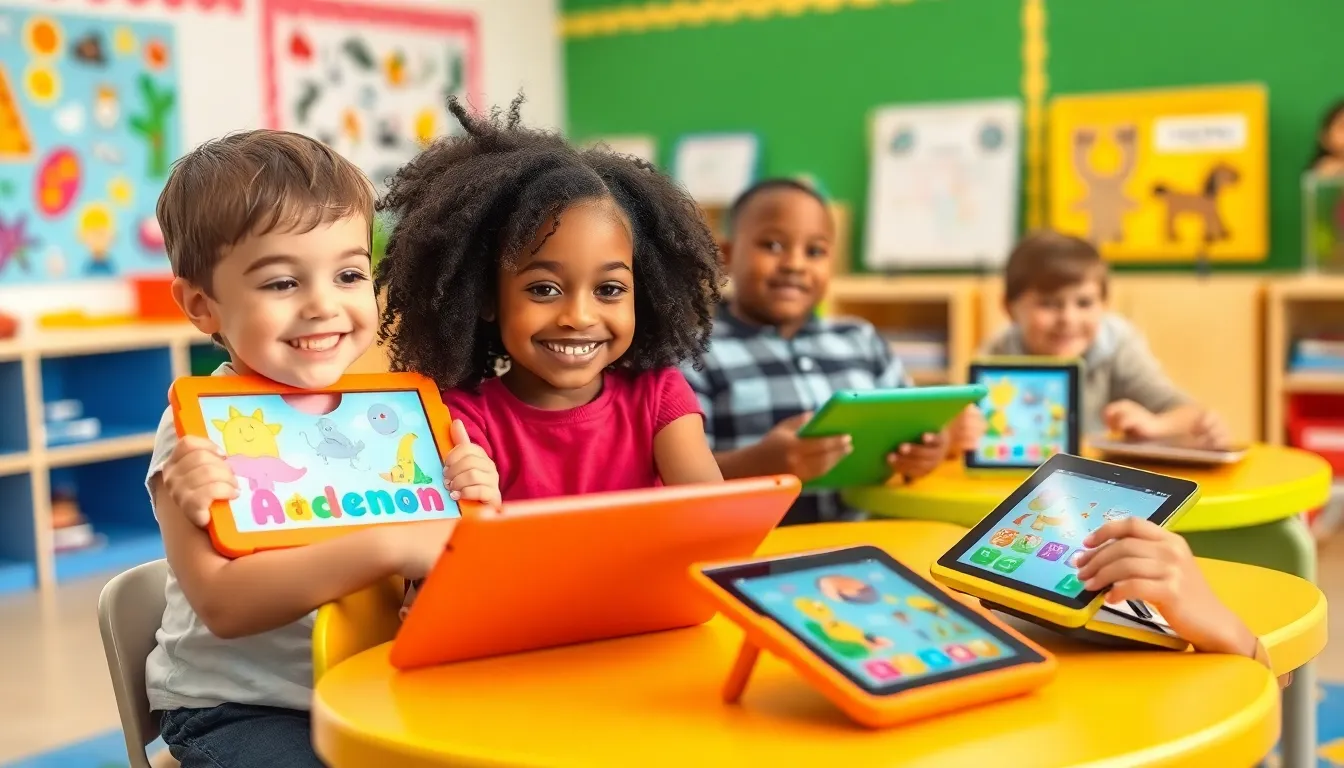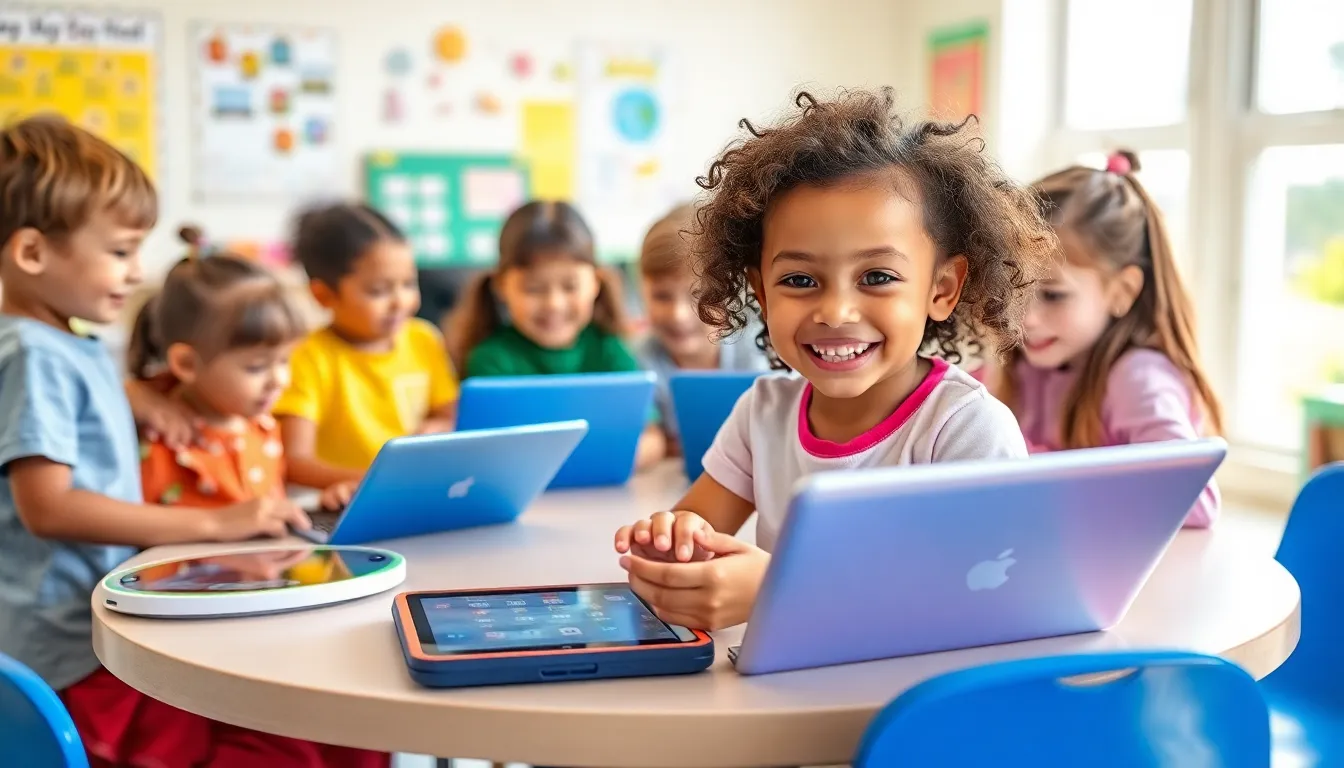Table of Contents
ToggleIn a world where toddlers seem to be born with a tablet in hand, the debate over preschool technology use is hotter than a spilled cup of coffee on a Monday morning. Parents and educators alike are grappling with how much screen time is just right for little ones. After all, who wouldn’t want their child to be the next tech whiz, coding by age five?
Overview of Preschool Technology Use
Preschool technology use continues to expand, influencing how children learn and interact. Digital devices, including tablets and computers, introduce young learners to essential skills early in their educational journey. Many educators recognize that technology enhances learning experiences through interactive applications and educational games.
Screen time recommendations suggest limited use for children under age two, yet some devices cater to early development needs. Great emphasis exists on choosing age-appropriate content that supports cognitive growth. Many preschool programs incorporate technology into curricula, allowing children to engage in problem-solving and creativity.
Studies indicate that 75% of preschoolers use mobile devices regularly. Exposure to educational resources online enhances literacy and numeracy skills among this age group. Teachers often leverage technology to track student progress, adapting lessons to individual needs dynamically.
Training educators in effective technology integration proves vital. Professional development focuses on balancing traditional teaching methods with modern tools, ensuring students benefit from both approaches. Communities increasingly recognize the role of technology in preparing children for future academic environments.
Parents often seek guidance on managing screen time at home. Collaborative efforts between educators and parents foster discussions around healthy technology use. Ongoing engagement not only aids in developing tech skills but also supports children’s overall learning experience, creating a harmonious balance between digital and hands-on play.
Benefits of Technology in Preschool Education

Technology in preschool education offers various advantages that significantly benefit young learners.
Enhancing Learning Experiences
Interactive apps and educational games engage preschoolers, making learning enjoyable. Real-time feedback helps children understand concepts quickly. Studies indicate that 75% of preschoolers regularly use mobile devices, which can enhance literacy and numeracy skills. Digital platforms adapt to individual learning paces, allowing children to progress in ways that suit their needs. Educators leveraging technology report improved classroom engagement, fostering an atmosphere that encourages curiosity.
Fostering Creativity and Imagination
Technology also fuels creativity and imagination among preschoolers. Creative applications allow children to design, draw, and build in a digital space. Engaging with multimedia encourages expressiveness beyond traditional art forms. Children develop problem-solving skills while navigating different challenges in interactive environments. By using technology, young learners can collaborate on projects, sharing ideas and expanding their creative horizons. Through these platforms, their imaginative potential finds a new outlet that complements hands-on activities.
Challenges of Preschool Technology Use
Technology in preschool settings presents several challenges, especially when it comes to managing screen time and ensuring content appropriateness.
Screen Time Concerns
Screen time poses significant concerns for young children. Recommendations suggest limited exposure for those under two, yet studies indicate that 75% of preschoolers regularly use mobile devices. Parents and educators may find it challenging to regulate usage effectively. Excessive screen time can lead to issues like diminished attention spans and reduced physical activity. Focus on balance is essential; interactive experiences can enhance learning, but they should not replace essential outdoor play. Establishing guidelines helps caregivers manage screen time, promoting healthier technology interactions.
Ensuring Appropriate Content
Content appropriateness plays a critical role in technology use. Age-appropriate materials ensure that digital experiences benefit cognitive development. Selection of educational apps and games becomes vital, as not all materials support learning effectively. Parents and educators are encouraged to review content proactively, seeking high-quality resources that engage preschoolers. Collaborative discussions enable families and educators to share recommendations, guiding children toward enriching content. As children explore technology, ensuring that it supports their growth remains a top priority.
Best Practices for Integrating Technology
Integrating technology into preschool environments requires careful consideration. Effective strategies can guide educators and parents in creating balanced learning experiences.
Balancing Screen Time and Traditional Learning
Managing screen time remains vital for preschoolers. Aim for a blend of digital activities and hands-on play to foster well-rounded development. Research indicates 75% of preschoolers use mobile devices regularly. This usage can enhance literacy and numeracy skills when combined with traditional learning methods. Encouraging physical play yields benefits such as improved attention spans and motor skills. Setting specific time limits for screen use fosters healthier interactions. Consistent routines can also help children transition smoothly between digital and physical activities. Ultimately, finding this balance promotes cognitive growth in young learners.
Involving Parents and Educators
Collaboration between parents and educators significantly impacts technology integration. Establishing open communication channels ensures that both parties understand their roles in managing screen time. Parents should actively participate in discussions about tech use, as their involvement strengthens the home-learning connection. Educators play a key role in guiding parents on selecting age-appropriate content. Regular workshops or informational sessions can provide valuable resources and strategies. Encouraging shared experiences, such as family tech nights, enhances relationships while promoting healthy technology habits. Engaging both parties leads to a supportive environment for preschoolers as they navigate the digital landscape.
Future Trends in Preschool Technology Use
Emerging trends indicate a significant increase in the adoption of augmented reality (AR) and virtual reality (VR) in preschool education. This technology allows young learners to experience interactive environments, enhancing engagement through immersive learning activities. The incorporation of AR and VR fosters creativity and collaboration, letting children explore complex concepts in a fun, hands-on way.
Personalized learning through artificial intelligence (AI) is another trend gaining traction. AI-driven applications adapt educational content to meet the individual needs of preschoolers, ensuring that every child progresses at their own pace. Observations show that tailored learning experiences can significantly improve literacy and numeracy skills among early learners.
Gamification is also reshaping how preschoolers interact with educational content. By integrating game-like elements, educators can motivate children to participate actively in their learning journeys. Many apps feature rewards and levels that not only entertain but also promote skill development.
The role of mobile devices is expected to evolve further, with predictions suggesting that 90% of preschoolers will engage with tablets by 2025. As digital literacy becomes a critical competency, preschool curricula increasingly incorporate technology to ensure that children develop essential skills for future success.
Collaboration between educational institutions and technology developers is essential in shaping effective content for young learners. Key stakeholders are encouraged to share insights and resources, fostering innovation in preschool technology tools.
Training programs for educators will likely expand, focusing on best practices for digital integration in classrooms. These initiatives aim to equip teachers with the skills necessary to balance technology and traditional learning methods effectively. Regular professional development opportunities will help educators stay updated with evolving technology trends.
Navigating the landscape of preschool technology use is essential for fostering a balanced educational experience. By embracing digital tools while maintaining traditional learning methods, educators and parents can create an environment that supports children’s growth. The focus on age-appropriate content and effective screen time management is crucial for promoting healthy interactions with technology.
As advancements in AR, VR, and AI reshape early education, collaboration between parents and educators will become increasingly vital. This partnership will ensure that preschoolers not only develop necessary tech skills but also enjoy a well-rounded learning journey. Prioritizing thoughtful integration of technology can lead to a future generation of innovative thinkers ready to thrive in a digital world.




